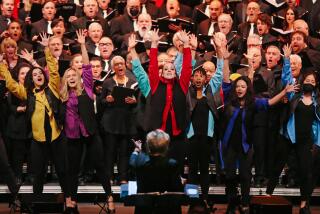Otherworldly Gregorian chants calling once again
- Share via
BETHLEHEM, Conn. — On a recent Monday at the Abbey of Regina Laudis, about 35 nuns gather in a dim chapel to chant, as they do every day at noon.
Making their way through Psalm 118, the nuns sit or stand; some face different directions, while others bow steeply. Throughout, their voices remain in unison.
Pope Benedict XVI would approve. After a concert of 16th and 17th century music recently, the pope said he would prefer to hear Gregorian chant and other traditional types of music play more of a role during Mass.
The Bethlehem abbey is known around the world for its devotion to Gregorian chant and is one of the few places where it is sung with such frequency and intensity. Nuns sing seven times a day; some interrupt their sleep to chant at 2 in the morning.
The pope’s comments raise certain questions: What is sacred music supposed to sound like? And what’s wrong with new music in church?
It’s a debate that has raged since 1963, when Vatican II reforms brought contemporary music to Catholic churches. Just as the Latin Mass almost immediately disappeared amid attempts to modernize, chants gave way to guitars and snappy folk tunes.
The new music helped fill pews, but it left church conservatives and formally trained musicians reeling. How could the church that brought about Gregorian chant, polyphony and musical notation -- all profound influences on Western music -- be the same one leading singalongs of “Love Is Colored Like a Rainbow” and songs from hit musicals? What, bemoaned the purists, had the folkies wrought?
Going to church, critics say, should not sound like shopping at the mall or driving your car. They charge that “liturgical pop” is spiritually bereft and demands nothing from the churchgoer. It’s friendly, pleasant and easy, they say. Understanding God is hard work, the argument goes, and similarly, music in church should challenge us. A sermon that says only what people want to hear would lack moral authority. The same goes for music.
“There’s a sense of mystery and religious atmosphere that seems to be lost in the new days,” says Scott Turkington, the choirmaster at St. John the Evangelist Roman Catholic Church in Stamford, Conn. “The fact is that the older music is better. Ask any serious musician, and he’ll agree with that.”
The chants sung at Regina Laudis are more than 1,000 years old. But Sister Elizabeth Evans says “old” doesn’t mean “irrelevant.” Sister Elizabeth, 46, was a corporate securities attorney and law professor before she came to the abbey in 1997. Each of the nuns is assigned certain responsibilities; hers are music and dairy. Sitting in a small room behind a wooden screen (which symbolically separates the nun’s world from the visitor’s, though there’s enough space to shake hands), Sister Elizabeth remembers stumbling onto the sound of chant when she was 14. To her, it was anything but off-putting. She played it for her friends, who were equally taken.
“And I mean, these were 14-year-old gum-chewing delinquents like myself,” she says.
To the untrained ear, the unaccompanied chant named after Pope Gregory the Great can sound emotionally muted, droning and otherworldly. That it’s sung in Latin doesn’t help. But to Sister Elizabeth, it sounds more recognizably human than any other music, down to earth and in tune to the rhythms of life.
It’s based on the Scriptures, after all, which are filled with human foibles. She says chant is like blues legend Muddy Waters. She explains that both have a certain earthiness and deal with the nitty-gritty of life.
What they chant depends on the time of the day (the morning lauds, for instance, often celebrate beginnings and creations; at noon, they chant the sext, which deals a lot with chasing down noonday demons). Subjects also change with the seasons. Lately, they’ve sung about harvests, filling storage houses and other day-to-day concerns.
So if chant is like Muddy Waters, what’s contemporary Christian music?
“Donny and Marie,” Sister Elizabeth says, laughing.
A few times, she holds her hands in prayer and makes an angelic face to gently mock the “niceness” of contemporary music. It’s got a steady 1-2-3 beat, she says, swaying her arm in rhythm. But life isn’t steady, or blandly inoffensive, for that matter. It has tumult and strife. So does chant, with a beat that goes back and forth and never settles. Rhythmically, she says, chant’s closest cousin may be jazz.
“There’s something in chant that calls to you even if you don’t understand the words,” she says.
Learning to sing Gregorian chant is difficult, maybe, but not impossible, says William Mahrt, a Stanford University music professor. “It may not be immediately sing-along-able; it may take some practice,” he says. A parish should be able to pick up most chants over the course of three or four Sundays.
Nobody’s expecting Gregorian chant to fill churches en masse. But many say the pendulum has been swinging toward traditional music.
“I think it’s kind of a generational thing,” says Kurt Poterack, editor of the journal Sacred Music. “You had one generation in the 1960s that had the general mode of questioning authority. Now you have, not quite the children, but the grandchildren. They tend to be people in their 20s who are saying, ‘Hey, this is kind of beautiful stuff.’ ”
More to Read
Sign up for Essential California
The most important California stories and recommendations in your inbox every morning.
You may occasionally receive promotional content from the Los Angeles Times.










